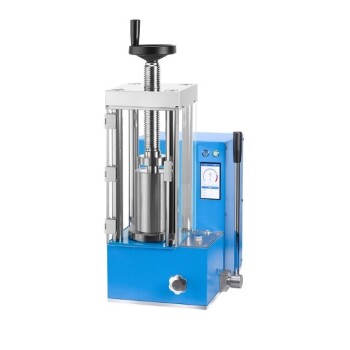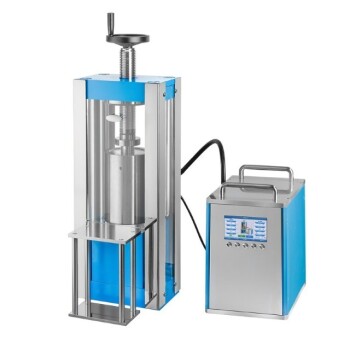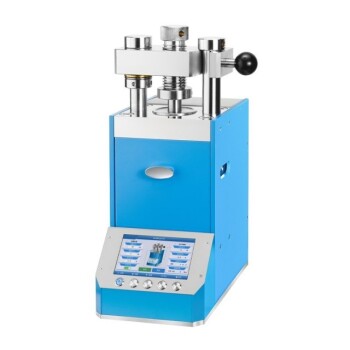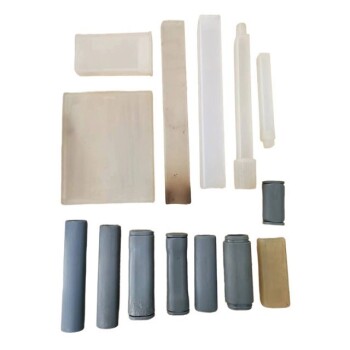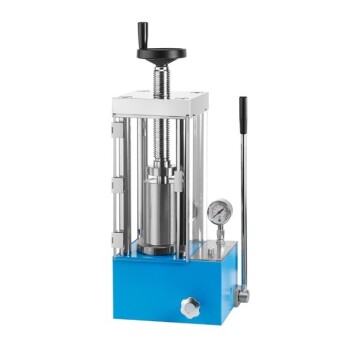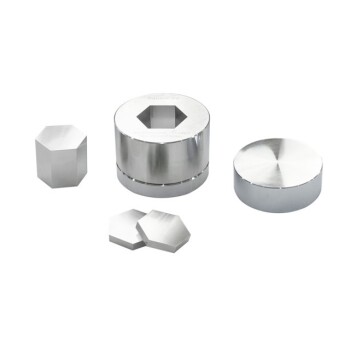At its core, isostatic pressing is a powder compaction process that forms a solid, dense object from a powder starting material. It achieves this by enclosing the powder within a flexible mold and subjecting it to extreme, uniform pressure from all directions using a fluid medium, such as water or gas. This all-around pressure is the key characteristic that distinguishes it from traditional methods.
The central challenge in powder metallurgy is achieving uniform density, as traditional presses create strong and weak zones within a part. Isostatic pressing solves this fundamental problem by applying equal pressure from every direction, resulting in highly consistent components with superior material properties, regardless of geometric complexity.
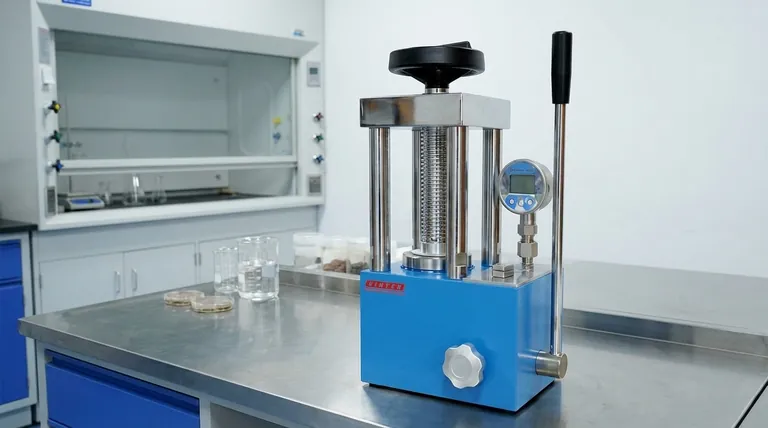
The Fundamental Principle: Uniformity Above All
Isostatic pressing is defined by its unique method of applying force. Unlike uniaxial pressing, which compacts material from one or two directions in a rigid die, isostatic pressing uses a fluid to ensure pressure is perfectly equalized across the entire surface of the part.
How It Works: Pressure from Every Angle
The powder is first loaded into a flexible, sealed container or mold. This entire assembly is then submerged in a fluid-filled pressure chamber.
An external pump pressurizes the fluid, which transmits the pressure equally and simultaneously to every point on the mold's surface. This eliminates the density gradients and internal stresses common in other methods.
The Role of the Flexible Mold
The mold is a critical component, typically made of rubber, urethane, or another elastomer. Its purpose is twofold: it contains the powder and faithfully transmits the hydraulic pressure to the material within it.
This flexible barrier prevents the pressurizing fluid from contaminating the powder while allowing the part to compact uniformly.
The Result: High, Consistent Density
By squeezing the powder from all sides at once, isostatic pressing systematically collapses voids and air pockets between the powder particles.
The outcome is a "green" part (an unsintered component) with exceptionally high and uniform density. This consistency translates directly to improved mechanical strength and predictable performance in the final, sintered product.
Key Advantages Over Traditional Methods
The uniform application of pressure gives isostatic pressing several distinct advantages, making it the preferred choice for demanding applications.
Superior Density and Green Strength
Parts produced via isostatic pressing are relatively free from the compact defects that can plague uniaxial pressing. The resulting high "green strength" makes the components robust enough to be handled and machined before the final sintering or heating stage.
Freedom in Geometric Complexity
Because the pressure is not directional, the process is not limited by the draft angles and simple shapes required by rigid dies. Isostatic pressing can produce highly complex and intricate shapes, including parts with undercuts or varying cross-sections.
Suitability for Difficult Materials
The process is exceptionally effective for compacting materials that are otherwise difficult to press, such as brittle ceramics and fine metallic powders. It also allows for highly efficient material utilization, which is critical when working with expensive or advanced materials.
Understanding the Process Controls and Variations
While the principle is straightforward, successful implementation requires careful control over several process parameters.
The Critical Role of Pressurization Rates
To ensure uniform compaction and prevent defects like cracking, the rates of pressurization and depressurization must be precisely controlled. Rushing this step can trap air or create internal stresses that compromise the final part.
Process Variations: Cold, Warm, and Hot
There are three principal techniques:
- Cold Isostatic Pressing (CIP): Performed at room temperature, typically using water or oil. It is used to create the green part before sintering.
- Warm Isostatic Pressing (WIP): Operates at elevated temperatures (below the sintering point) to improve powder plasticity.
- Hot Isostatic Pressing (HIP): Combines extreme pressure with high temperatures, simultaneously compacting and sintering the powder into a fully dense part.
Equipment and Medium Considerations
CIP systems operate at immense pressures, often ranging from 400 MPa (60,000 psi) to over 1,000 MPa (150,000 psi). The working fluid is typically water mixed with a corrosion inhibitor or a specialized oil.
Making the Right Choice for Your Goal
Understanding these characteristics helps you decide when to specify or employ isostatic pressing for a given manufacturing challenge.
- If your primary focus is creating complex shapes with high green strength before sintering: Cold Isostatic Pressing (CIP) is the ideal choice for its versatility and effectiveness at room temperature.
- If your primary focus is achieving near-perfect, 100% density in a final component: Hot Isostatic Pressing (HIP) is the definitive solution, as it eliminates all residual porosity.
- If your primary focus is minimizing material waste with expensive or brittle powders: Isostatic pressing provides superior material utilization and can successfully compact materials that fail in other processes.
Ultimately, isostatic pressing offers a powerful solution for creating high-performance components that are free from the limitations of traditional compaction methods.
Summary Table:
| Characteristic | Description |
|---|---|
| Pressure Application | Uniform from all directions via fluid medium |
| Key Advantage | Eliminates density gradients, ideal for complex geometries |
| Process Types | Cold Isostatic Pressing (CIP), Warm Isostatic Pressing (WIP), Hot Isostatic Pressing (HIP) |
| Material Suitability | Brittle ceramics, fine metallic powders, high-value materials |
| Green Part Density | High and consistent, leading to improved mechanical strength |
Ready to enhance your laboratory's capabilities with precise powder compaction? KINTEK specializes in high-performance lab press machines, including automatic lab presses, isostatic presses, and heated lab presses. Our solutions deliver uniform density, superior material properties, and efficiency for complex part production. Contact us today to discuss how our equipment can meet your specific needs and drive innovation in your projects!
Visual Guide

Related Products
- Electric Lab Cold Isostatic Press CIP Machine
- Electric Split Lab Cold Isostatic Pressing CIP Machine
- Automatic Lab Cold Isostatic Pressing CIP Machine
- Lab Isostatic Pressing Molds for Isostatic Molding
- Manual Cold Isostatic Pressing CIP Machine Pellet Press
People Also Ask
- What are some examples of applications for cold isostatic pressing? Boost Your Material Performance with Uniform Compaction
- What are the standard specifications for Production Cold Isostatic Press Systems? Optimize Your Material Compaction Process
- What industries commonly use Cold Isostatic Pressing? Unlock Superior Material Integrity
- What industries benefit from Cold Isostatic Pressing technology? Ensure Reliability in Aerospace, Medical, and More
- What are the advantages of Cold Isostatic Pressing for ceramic production? Achieve Uniform Density and Complex Shapes
